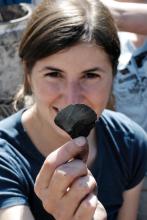Depth of Field: (1) The range of object distances within a photograph that are imaged with acceptable sharpness; (2) the relative experience of fieldwork.
TTL: [Through the Lens] (1) Metering system that measures light or exposure through the taking lens of a camera; (2) manner of observation: perspective.
Nepalese medical camps, American military video games, IV drug use in Ukraine, Granada’s island archaeology, indigenous collaborative research with Pacific Northwest Native American Tribal Elder, hair salons in Anhui Province, China, signalling theory in Peru, and reproductive endocrinology in the Bolivian Amazon. Believe it or not, they all having something in common—anthropology. And while we might focus our attention on what anthropologists produce in the way of texts, anthropologists also increasingly call on visual media as part of their research. With that in mind, the Department of Anthropology Diversity Committee has sponsored a year-long photo exhibit of students’ visual work in the field from all over the world. Beginning as an installation in Odegaard’s West Wall photo cases (behind circulation), the photos will be moved to Denny 401 in spring, where they will spend the rest of the academic year.
“That photograph was taken literally as I stepped off the train, alone, in Odessa, Ukraine, to begin my very first experience conducting ethnographic fieldwork,” says Jennifer Carroll, sociocultural graduate student, of her image showing a young woman on a cell phone walking along a platform. “It was also the first time I had ever travelled abroad alone,” she continues. “My camera became a tool for helping me to see the city, learn the city, and cope with my fears of the city.”
For some, fieldwork means traveling to places never before visited. For archaeology graduate student, Molly Odell, it means going home. Asked to describe one of her photographs, which features her friend, Katelyn Sikes, holding a flake from a prehistoic stone adze in Kodiak Alaska, Odell says, “I began my career as an archaeologist the summer after I graduated from high school at the Alutiiq Museum’s Community Archaeology Program on Kodiak Island, Alaska. Ten years later, I've been able to return and co-direct a series of excavations related to my dissertation and to introduce other residents of Kodiak, including my friend Katelyn, to archaeological fieldwork and the remarkable culture, both past and present, of the Alutiiq people.”
Whether used as a tool to understand or document, the camera has long been part of the anthropologist’s tool kit. This photo exhibit invites observers to ask questions about how an image is framed, why certain elements are foregrounded while others fall into the distance, what is in focus, and what remains indistinct? What is, in the end, the depth of field? The Diversity Committee is proud to bring together and showcase such stellar visual work from our anthropology students and hopes that this exhibit will generate fruitful conversations for people across the sub-disciplines of anthropology and across campus.
A heartfelt thanks goes to Graduate Student Stephanie Maher, who was the primary visionary and organizing force behind this remarkable exhibit, which succeeded in creating a moving intellectual space for diversity in our program.
If you have a Facebook account, you can view the entire collection of photographs from the exhibit.

